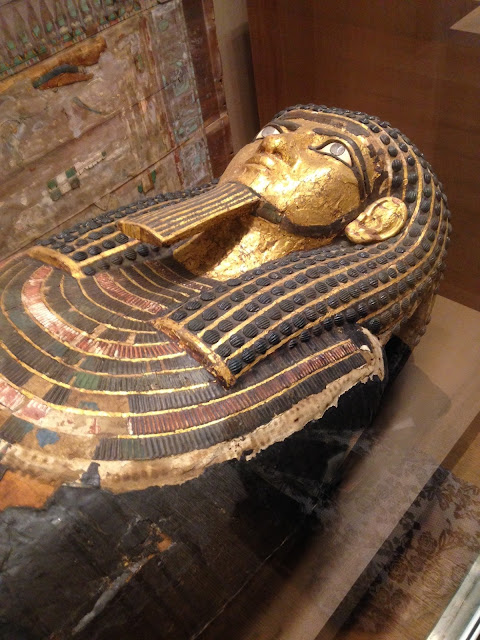Day 382 - Early Netherlandish painting
October 31, 2024
Gallery 605 turns out to be dedicated to Early Netherlandish painting, and it's my favorite among the "600" galleries so far. for reasons that aren't altogether clear to me. Is it that most of the painters' names are familiar to me, among them, Bosch (the "Adoration of the Magi" scene I described on Day 227 has been rehung here), Gerard David, and Petrus Christus? Is it that the signage makes clear the connections between Netherlandish and Italian painters in the 15th century? Is it the luminosity of the works themselves? Is it that Rogier van der Weyden's portrait of Francesco d'Este greets me as I enter the gallery, and I instinctively know that I want to write about it before I look at anything else?
I've always liked this small portrait, which measures only about 17 inches high and 10 inches wide. At first, I imagined it to be a wedding portrait because Francesco holds a ring delicately between his right thumb and index finger. I didn't notice that he also holds a hammer; the placard suggests that the hammer and ring may have been jousting prizes. If it were a wedding portrait, it would not cause his intended to view her impending nuptials with joy. Francesco has a long, bony, unsmiling face; the uneven bangs that nearly cover his forehand do not enhance our estimates of his intelligence. Van der Weyden, I learn, was the leading court portraitist in the Netherlands, but he evidently didn't feel the need to flatter his subjects, and that may be one reason I like this work so much. But I also admire the painter's technique, especially the very thin brushstrokes of yellow paint used to mark each link in the chain necklace Francesco wears.
Maybe because it's Halloween, I also want to write about a long, skinny (perhaps 24 inches tall and 12 inches wide) painting by Jan van Eyck depicting the Crucifixion and the Last Judgment. Christ sits enthroned in Heaven at the top of the panel, surrounded by angels, the Virgin, and a saint I don't recognize (Joseph?) . Below him are the saved. In the center are neat rows - sex-segregated! - of men wearing white robes and women wearing dark dresses. some holding books. (Are the books psalters? Are the men and women members of a heavenly choir?). Surrounding them toward the edges of the panel are, on one side, clergymen, including bishops with their miters and monks with their tonsures, on the other, kings and burghers. In stark contrast, the vision of Hell in the lower half of the painting is gruesome. Naked bodies writhe in a contorted heap in a dark, cavernous space, from which they are prevented from escaping not only by a guardian angel but by a large skeleton with outstretched arms and legs whose grimacing skull is truly spooky.
What's amazing is how many figures van Eyck managed to fit onto this small canvas - I counted at least 70 - and how individuated they are. The descriptive placard says, "The artist's expansive yet microscopic paintings seem observed through both a microscope and a telescope." Kudos to whoever wrote this.






Comments
Post a Comment